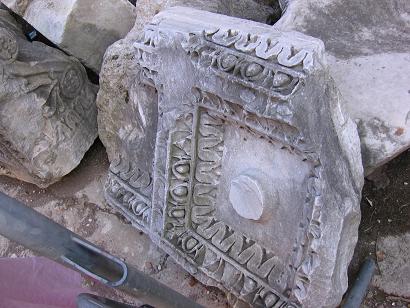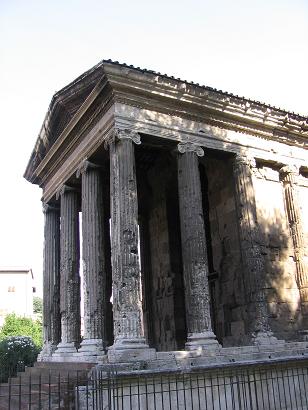|
|
 |
|
082505 Italian and Ancient Temples |
|
written
by sariah / 08.30.2005 |
|
|
| |
Itinerary |
| |
The bright sounds of vendors setting up in the Campo di Fiori help to propel the early morning routines of the women in the apartment above it. Even with the windows sealed and locked, the clanking of metal stall stands and the good natured Italian shouts reach muffled through the shutters. The comforting sounds of activity help us off of the mattress even when the room itself is pitch dark. I am always surprised when I stagger into the kitchen towards the shower to see bright sunlight through frosted glass windows.
Our scheduled appointments for the day begin with Italian class at the Italiadea offices, just a few meters off the main piazza of the Campo di Fiori. These are our first actual lessons, after a basic orientation to Rome and a tour of the “Campo’s” neighboring area of Travestere. Split into two different groups for the language lessons, the first goal is to list all the Italian we know. The brainstormed list is diverse, reflecting our varied needs during the first few days’ Roman adventures, from the ubiquitous buongiorno (good day) to cornetto (croissant) to estate (summer). From this task we move toward forming a more solid framework of Italian knowledge, as opposed to chance phrases stolen from Spanish or English, embellished with stereotyped Italian accents and energetic hand motions.
We start again four hours later. To get to the Forum Boralius, Lisa leads us amongst the cobblestone streets of the Jewish Ghetto. Through my inexperienced eyes, the transitions between neighborhoods in Rome are difficult to perceive, and I only realize we have entered the Jewish Ghetto from the printed “Kosher” on restaurant awnings. Otherwise, the ocher multistoried buildings framing the one-car alleys seem similar from the Campo to the Jewish Ghetto. We pause briefly to admire the stately Theater of Marcellus which was begun by Julius Caesar. Completed by Augustus in 13 BCE to honor his nephew Marcellus, the theater today stands firmly and commandingly, without any of the raucous atmosphere that accompanied the entertainments held for 15,000 ancient Roman guests. In fact, the upper stories now serve as luxury apartments with undoubtedly amazing views of the city. Three corner columns of the Temple of Apollo remain meters away from the Theater. Smaller in height than the Theater of Marcellus, these columns entice attention with their bright white, fluted shape and engraved cornice chunk on the apex.
The walk continues along the traffic of the Via Petroselli, towards the Temple of Portunus. Turning away from the busy highway, we sit in the shade and listen to Julie describe the fantastic, but widely accepted, account of Rome’s founding. The story involves fratricide, a maternal she-wolf, deceptive celebrations, mass rape, subsumption of a half-mortal by gods and Rome’s founding date of 753 BCE, a date verified by archeological evidence.
Our attention then moves to the Temple of Portunus itself, built in first century BCE to honor the Roman god of rivers and seaports. Built of tufa, a volcanic stone that hardens with exposure to air, the Temple of Portunus was converted to the Church of St. Mary in 872 ACE. Its conversion to a church accounts for the unusually excellent preservation. Rectangular in shape, the Portunus has an open columned portico and an enclosed back area. Straight iron gates surround the Temple for its protection, and a handful of pigeons roam through the green, dusty grass around its base. In the afternoon, the Temple of Portunus is completely shaded, with a dusky gray color that does not belie its more than two thousand year-old age. Near the Temple of Portunus, in a more sun and traffic-exposed location, stands the round Temple of Hercules. Also built in the first century BCE, this Temple’s unusual round shape is likely the result of Greek influence. Outer Corinthian columns surround a cylindrical enclosed space, all underneath a shallow cone-shaped roof. The planned excursion ends here. Our group splits to wander through the Roman forum, find ever enticing gelato or walk towards other numerous, amazing sites of Rome.
|
| |
|
| |
|
| |
Highlights |
| |
Experiencing the juxtaposition of the Temple of Hercules and a major, modern highway highlighted today’s excursion. The incongruity of viewing the ancient, round temple at one angle, and then turning 180 degrees to see tiny smart cars and scooters racing by, epitomizes my impression of Rome thus far. This visual comparison between the ancient and modern, only emphasizes how startling it is to live in at the center of a city where thousand-year-old structures are commonplace.
|
| |
|
| |
|
| |
Images |
| |
| |

|
| By Sariah Khormaee |
| Building Materials |
| Near the Theater of Marcellus, scattered remains of heavily engraved ancient buildings lie in small piles. This is typical at the bases of Rome’s many ancient monuments. |
| |
|
| |

|
| By Sariah Khormaee |
| Temple of Apollo |
| Three columns of the Temple of Apollo, near the Theater of Marcellus, stand straight against the sunny skies. |
| |
|
| |

|
| By Sariah Khormaee |
| Temple of Portunus |
| The Temple of Portunus in its shaded glory. From this photograph, you can view the columned portico and enclosed back area. |
| |
|
|
| |
|
| |
|
|
 |
|
